Ecoregional Patterns of Spruce Budworm—Wildfire Interactions in Central Canada’s Forests
Abstract
:1. Introduction
2. Data and Methods
2.1. Spruce Budworm Defoliation Data
2.2. Fire Data
2.3. Forest Data
2.4. Climate Data
2.5. Classification Tree (CART) Analysis
3. Results
3.1. Locating Where Spruce Budworm Defoliation Contributed to Fire Potential
3.2. Error Analysis
4. Discussion
5. Conclusions
Acknowledgments
Author Contributions
Conflicts of Interest
References
- Weber, M.G.; Flannigan, M.D. Canadian Boreal Forest Ecosystem Structure and Function in a Changing Climate: Impact on Fire Regimes. Environ. Rev. 1997, 5, 145–166. [Google Scholar] [CrossRef]
- Fleming, R.A. Climate Change and Insect Disturbance Regimes in Canada’s Boreal Forests. World Resour. Rev. 2000, 12, 520–554. [Google Scholar]
- Jasinski, J.P.P.; Payette, S. The creation of alternative stable states in the southern boreal forest, Québec, Canada. Ecol. Monogr. 2005, 75, 561–583. [Google Scholar] [CrossRef]
- Girard, F.; Payette, S.; Gagnon, R. Rapid expansion of lichen woodlands within the closed-crown boreal forest zone over the last 50 years caused by stand disturbances in eastern Canada. J. Biogeogr. 2008, 35, 529–537. [Google Scholar] [CrossRef]
- Candau, J.-N.; Fleming, R.A. Forecasting the response of spruce budworm defoliation to climate change in Ontario. Can. J. For. Res. 2001, 41, 1948–1960. [Google Scholar] [CrossRef]
- Wang, X.; Thompson, D.; Marshall, G.A.; Tymstra, C.; Carr, R.; Flannigan, M.D. Increasing frequency of extreme fire weather in Canada with climate change. Clim. Chang. 2015, 130, 573–586. [Google Scholar] [CrossRef]
- Forestry Canada Fire Danger Group. Development and Structure of the Canadian Forest Fire Behavior Prediction System; Forestry Canada Science and Sustainable Development Directorate, Information Report ST-X-3 (Ottawa, ON); Forestry Canada Fire Danger Group: Ottawa, ON, Canada, 1992; p. 64. [Google Scholar]
- Kurz, W.A.; Stinson, G.; Rampley, G.J.; Dymond, C.C.; Neilson, E.T. Risk of natural disturbances makes future contribution of Canada’s forests to the global carbon cycle highly uncertain. Proc. Natl. Acad. Sci. USA 2008, 105, 1551–1555. [Google Scholar] [CrossRef] [PubMed]
- Dymond, C.C.; Neilson, E.T.; Stinson, G.; Porter, K.; MacLean, D.A.; Gray, D.R.; Campagna, M.; Kurz, W.A. Future Spruce Budworm Outbreak May Create a Carbon Source in Eastern Canadian Forests. Ecosystems 2010, 13, 917–931. [Google Scholar] [CrossRef]
- Graham, S.A. The Dying Balsam Fir and Spruce in Minnesota; University of Minnesota Agricultural Experiment Station, Special Bulletin 68, St. Paul, MN; University of Minnesota Agricultural Experiment Station: Minneapolis, MN, USA, 1923. [Google Scholar]
- Swaine, J.M.; Craighead, F.C.; Bailey, I.W. Studies on the Spruce Budworm (Cacoecia fumiferana Clem.); Department of Agriculture: Ottawa, ON, Canada, 1924. [Google Scholar]
- Prebble, M.L. The Battle of the Budworm. Pulp Pap. Can. 1950, 51, 150–155. [Google Scholar]
- Baskerville, G.L. Spruce Budworm: Super Silviculturist. For. Chron. 1975, 61, 138–140. [Google Scholar]
- Stocks, B.J. Forest Fire Behavior in Spruce Budworm-killed Balsam Fir. In Advances in Spruce Budworms Research, Proceedings of the CANUSA Spruce Budworms Research Symposium Recent, Bangor, ME, USA, 16–20 September 1984; Canadian Forest Service: Ottawa, ON, Canada, 1985; pp. 198–209. [Google Scholar]
- Stocks, B.J. Fire Potential in the Spruce Budworm-damaged Forests of Ontario. For. Chron. 1987, 63, 8–14. [Google Scholar] [CrossRef]
- Péch, G. Fire hazard in budworm-killed balsam fir stands on Cape Breton Highlands. For. Chron. 1993, 69, 178–186. [Google Scholar] [CrossRef]
- Fleming, R.A.; Candau, J.-N.; McAlpine, R.S. Landscape analysis of interactions between insect defoliation and forest fire in central Canada. Clim. Chang. 2002, 55, 251–272. [Google Scholar] [CrossRef]
- Watt, G.A. Enhanced Vertical Fuel Continuity in Forests Defoliated by Spruce Budworm (Choristoneura fumiferana Clem.) Promotes the Transition of a Surface Fire into a Crown Fire. Ph.D. Thesis, Faculty of Forestry, University of Toronto, Toronto, ON, Canada, 2014. [Google Scholar]
- James, P.M.; Robert, L.E.; Wotton, B.M.; Martell, D.L.; Fleming, R.A. Lagged cumulative spruce budworm defoliation affects the risk of fire ignition in Ontario, Canada. Ecol. Appl. 2017, 27, 532–544. [Google Scholar] [CrossRef] [PubMed]
- Candau, J.-N.; Fleming, R.; Hopkin, A. Spatiotemporal patterns of large-scale defoliation caused by the spruce budworm in Ontario since 1941. Can. J. For. Res. 1998, 28, 1733–1741. [Google Scholar] [CrossRef]
- Sippell, W.L. A review of the spruce budworm and its outbreak history. In Proceedings of the Spruce Budworm Problem in Ontario—Real or Imaginary? Timmins, ON, Canada, 14–16 September 1983; Sanders, C.J., Carrow, J.R., Eds.; Canadian Forest Service: Sault Ste. Marie, ON, Canada, 1983; pp. 17–25. [Google Scholar]
- Hardy, Y.; Mainville, M.; Schmitt, D.M. An Atlas of Spruce Budworm Defoliation in Eastern North America, 1938–1980; USDA Forest Service, Miscellaneous Publication Number 1449; USDA Forest Service: Beltsville, MD, USA, 1986.
- Candau, J.-N.; Fleming, R.A. Landscape scale spatial distribution of spruce budworm defoliation in relation to bioclimatic conditions. Can. J. For. Res. 2005, 35, 2218–2232. [Google Scholar] [CrossRef]
- Stocks, B.J.; Mason, J.A.; Todd, J.B.; Bosch, E.M.; Wotton, B.M.; Amiro, B.D.; Flannigan, M.D.; Hirsch, K.G.; Logan, K.A.; Martell, D.L.; et al. Large forest fires in Canada, 1959–1997. J. Geophys. Res. 2002, 107. [Google Scholar] [CrossRef]
- Bergeron, Y.; Leduc, A.; Harvey, B.D.; Gauthier, S. Natural fire regime: A guide for sustainable management of the Canadian boreal forest. Silva Fenn. 2002, 36, 81–95. [Google Scholar] [CrossRef]
- Parisien, M.-A.; Peters, V.S.; Wang, Y.; Little, J.M.; Bosch, E.M.; Stocks, B.J. Spatial patterns of forest fires in Canada, 1980–1999. Int. J. Wildland Fire 2006, 15, 361–374. [Google Scholar] [CrossRef]
- Bergeron, Y.; Leduc, A. Relationships between change in fire frequency and mortality due to spruce budworm outbreak in the southeastern Canadian boreal forest. J. Veg. Sci. 1998, 9, 493–500. [Google Scholar] [CrossRef]
- Bouchard, M.; Kneeshaw, D.; Bergeron, Y. Forest dynamics after successive spruce budworm outbreaks in mixedwood forests. Ecology 2006, 87, 2319–2329. [Google Scholar] [CrossRef]
- Simard, I.; Morin, H.; Lavoie, C. A millennial-scale reconstruction of spruce budworm abundance in Saguenay, Quebec, Canada. Holocene 2006, 16, 31–37. [Google Scholar] [CrossRef]
- Hély, C.; Bergeron, Y.; Flannigan, M.D. Effects of stand composition on fire hazard in mixed-wood Canadian boreal forest. J. Veg. Sci. 2000, 11, 813–824. [Google Scholar] [CrossRef]
- Ontario Ministry of Natural Resources. Forest Resources of Ontario 1996; Ontario Ministry of Natural Resources: Peterborough, ON, USA, 1996.
- McKenney, D.W.; Pedlar, J.H.; Papadopol, P.; Hutchinson, M.F. The development of 1901–2000 historical monthly climate models for Canada and the United States. Agric. For. Meteorol. 2006, 138, 69–81. [Google Scholar] [CrossRef]
- Hogg, E.H. Temporal scaling of moisture and the forest–grassland boundary in Western Canada. Agric. For. Meteorol. 1997, 84, 115–122. [Google Scholar] [CrossRef]
- Girardin, M.P.; Tardif, J.; Flannigan, M.D.; Wotton, B.M.; Bergeron, Y. Trends and periodicities in the Canadian Drought Code and their relationships with atmospheric circulation for the southern Canadian boreal forest. Can. J. For. Res. 2004, 34, 103–119. [Google Scholar] [CrossRef]
- De’ath, G.; Fabricius, K.E. Classification and regression trees: A powerful yet simple technique for ecological data analysis. Ecology 2000, 81, 3178–3192. [Google Scholar] [CrossRef]
- Draper, N.R.; Smith, H. Applied Regression Analysis; Wiley: New York, NY, USA, 1981. [Google Scholar]
- Breiman, L. Random forests. Mach. Learn. 2001, 45, 5–32. [Google Scholar] [CrossRef]
- Liaw, A.; Wiener, M. Classification and regression by random Forest. R News 2002, 2, 18–22. [Google Scholar]
- Nealis, V.G.; Régnière, J. Insect–host relationships influencing disturbance by the spruce budworm in a boreal mixedwood forest. Can. J. For. Res. 2004, 34, 1870–1882. [Google Scholar] [CrossRef]
- Taylor, S.W.; Woolford, D.G.; Dean, C.B.; Martell, D.L. Wildfire prediction to inform fire management: Statistical science challenges. Stat. Sci. 2013, 28, 586–615. [Google Scholar] [CrossRef]
- Wang, X.; Parisien, M.-A.; Flannigan, M.D.; Parks, S.A.; Anderson, K.R.; Little, J.M.; Taylor, S.W. The potential and realized spread of wildfires across Canada. Glob. Chang. Biol. 2014, 20, 2518–2530. [Google Scholar] [CrossRef] [PubMed]
- Légaré, S.; Bergeron, Y.; Paré, D. Influence of forest composition on understory cover in Boreal mixedwood forests of western Quebec. Silva Fenn. 2002, 36, 353–366. [Google Scholar] [CrossRef]
- Wan, H.; Wang, X.L.; Swail, V.R. Homogenization and trend analysis of Canadian near-surface wind speeds. J. Clim. 2010, 23, 1209–1225. [Google Scholar] [CrossRef]
- Colombo, S.J.; McKenney, D.W.; Lawrence, K.M.; Gray, P.A. Climate Change Projections for Ontario: Practical Information for Policymakers and Planners; Ontario Ministry of Natural Resources, Applied Research and Development Branch, Climate Change Research Report CCRR-05; Ontario Ministry of Natural Resources: Sault Ste. Marie, ON, Canada, 2007; p. 38.
- Li, C. Fire regimes and their simulation with reference to Ontario. In Ecology of a Managed Terrestrial Landscape: Patterns and Processes of Forest Landscapes in Ontario; Perera, A.H., Euler, D.L., Thompson, I.D., Eds.; UBC Press: Vancouver, BC, Canada, 2000; pp. 115–140. [Google Scholar]
- Brooks, J.R.; Flanagan, L.B.; Ehleringer, J.R. Responses of boreal conifers to climate fluctuations: Indications from tree-ring widths and carbon isotope analyses. Can. J. For. Res. 1998, 28, 524–533. [Google Scholar] [CrossRef]
- Lenihan, J.M.; Neilson, R.P. Canadian vegetation sensitivity to projected climatic change at three organizational levels. Clim. Chang. 1995, 30, 27–56. [Google Scholar] [CrossRef]
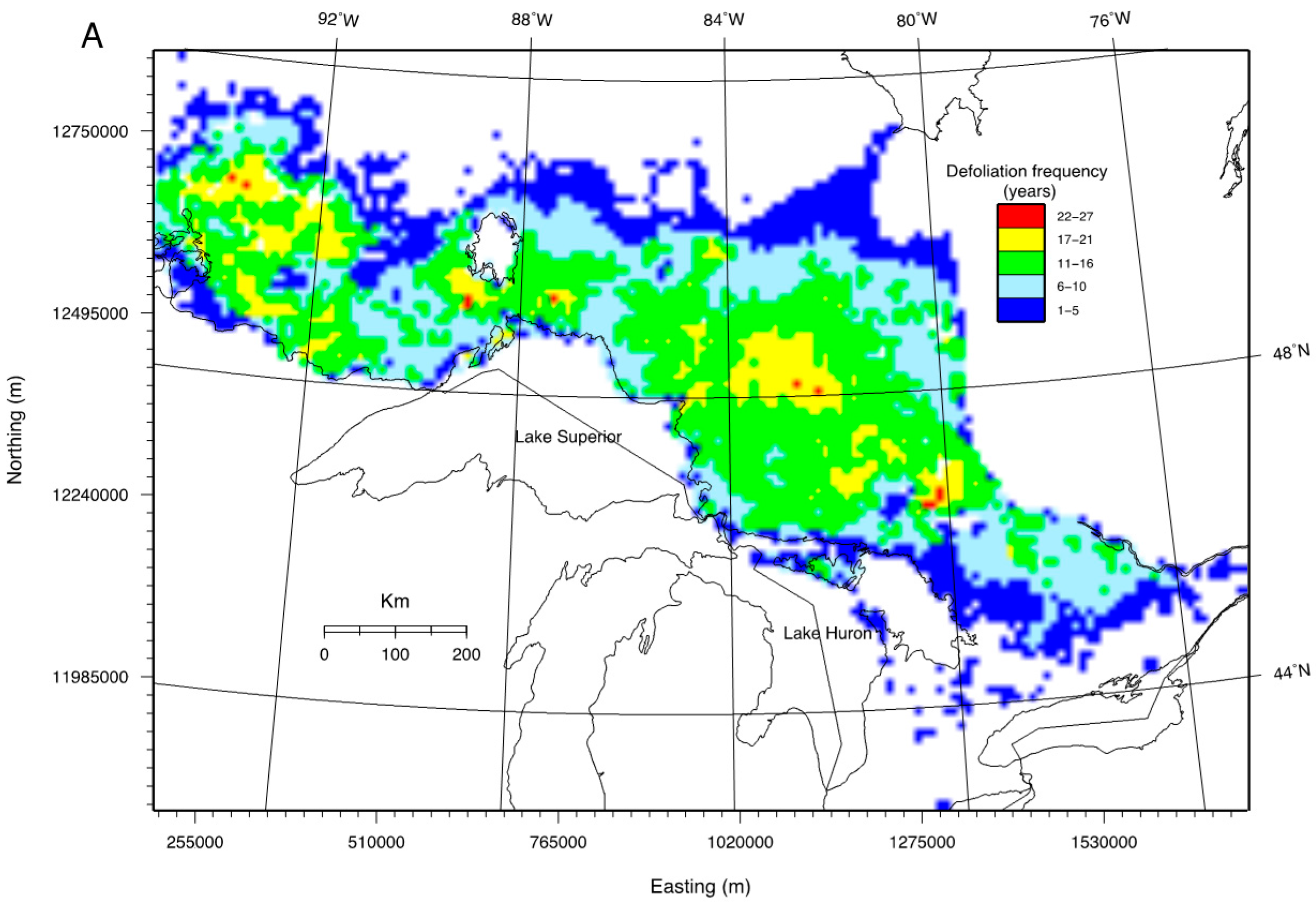
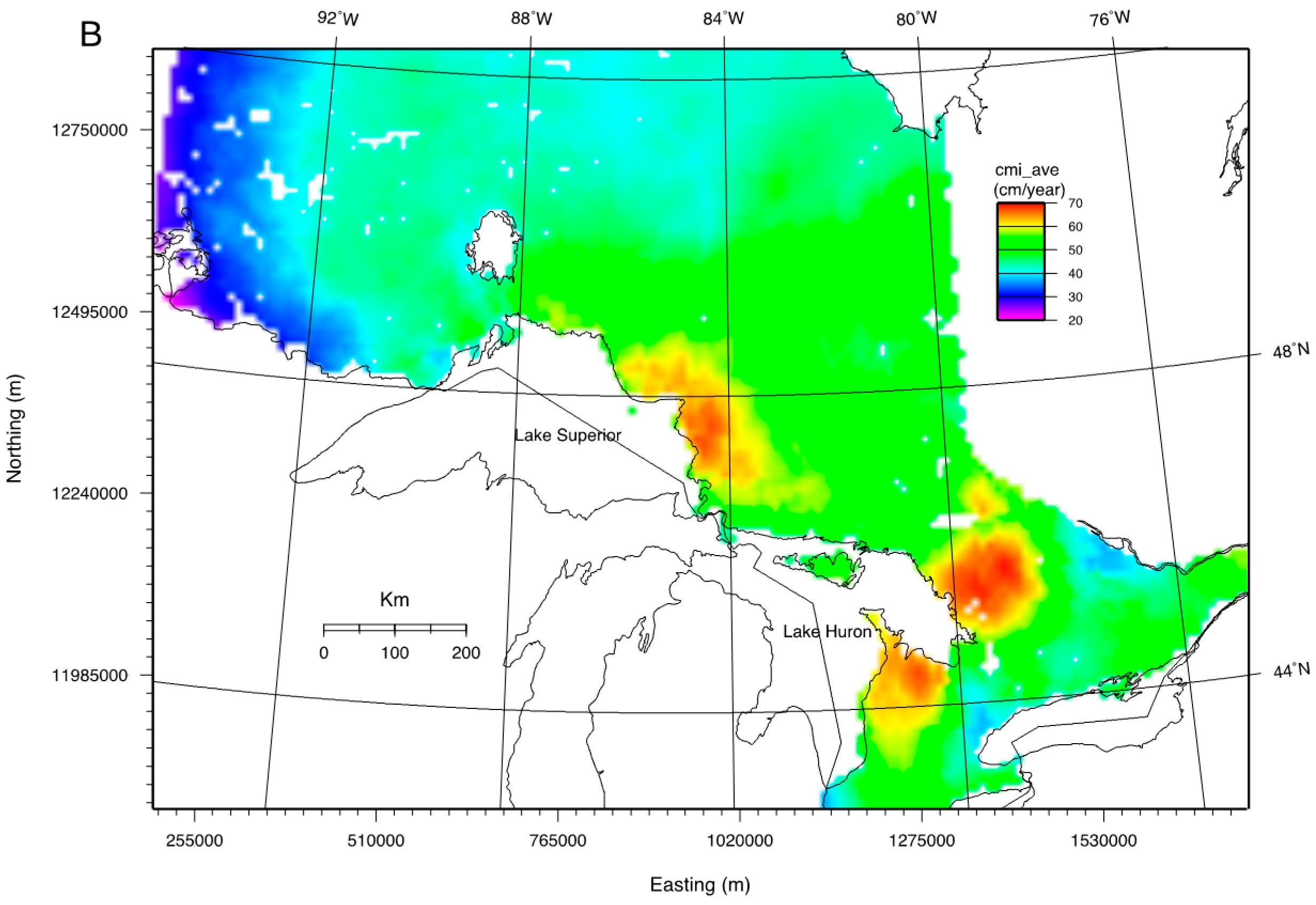
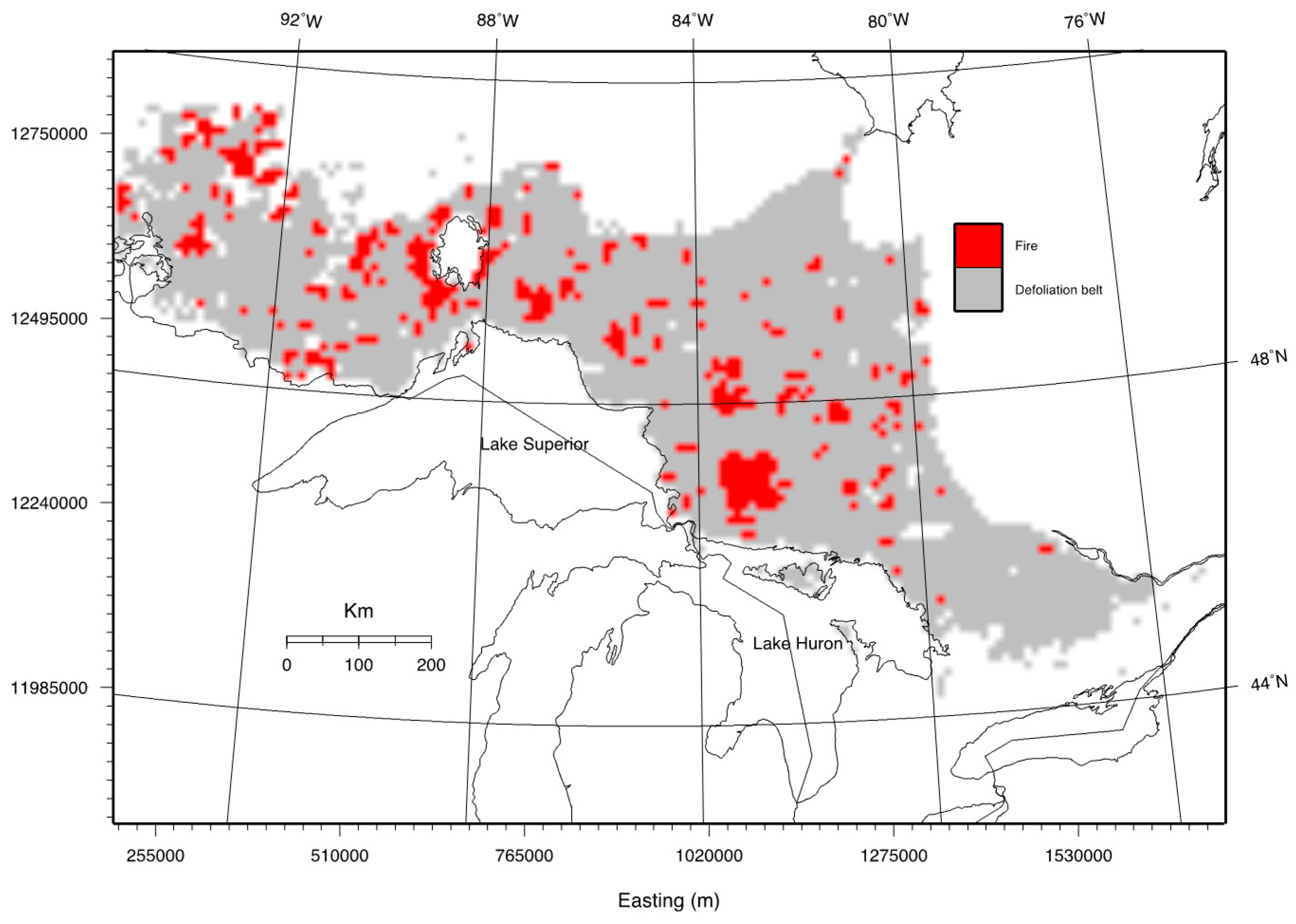
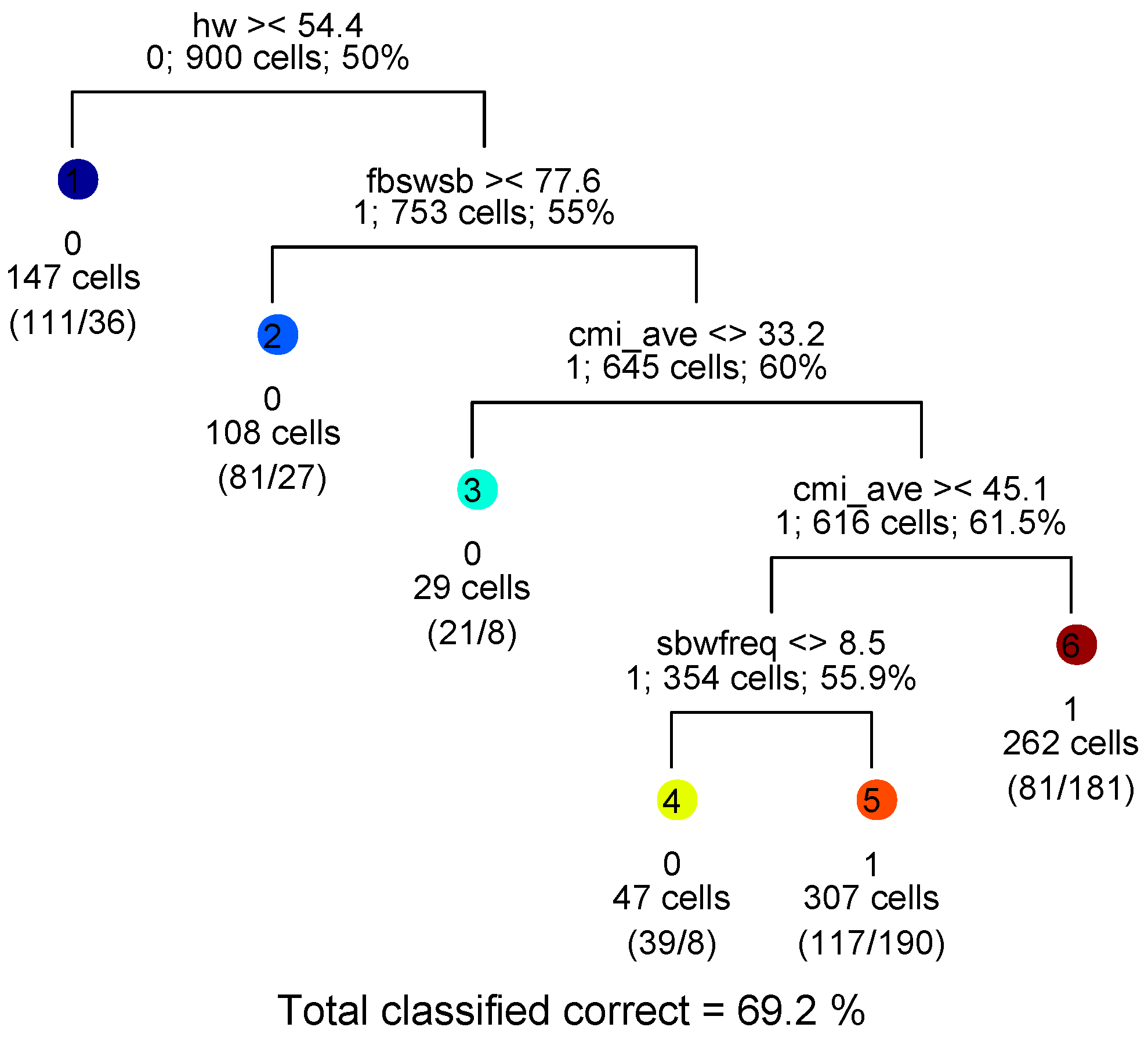
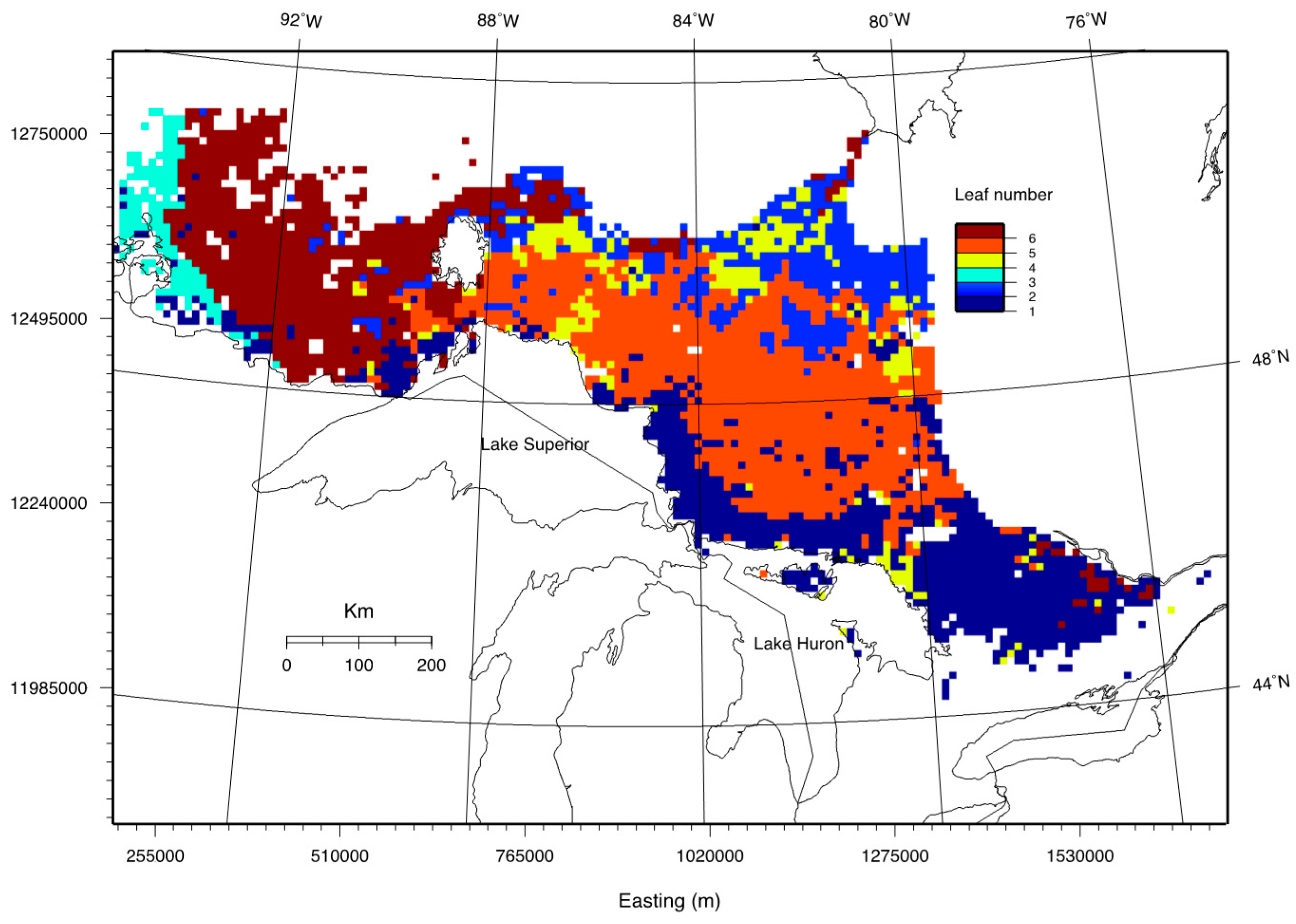
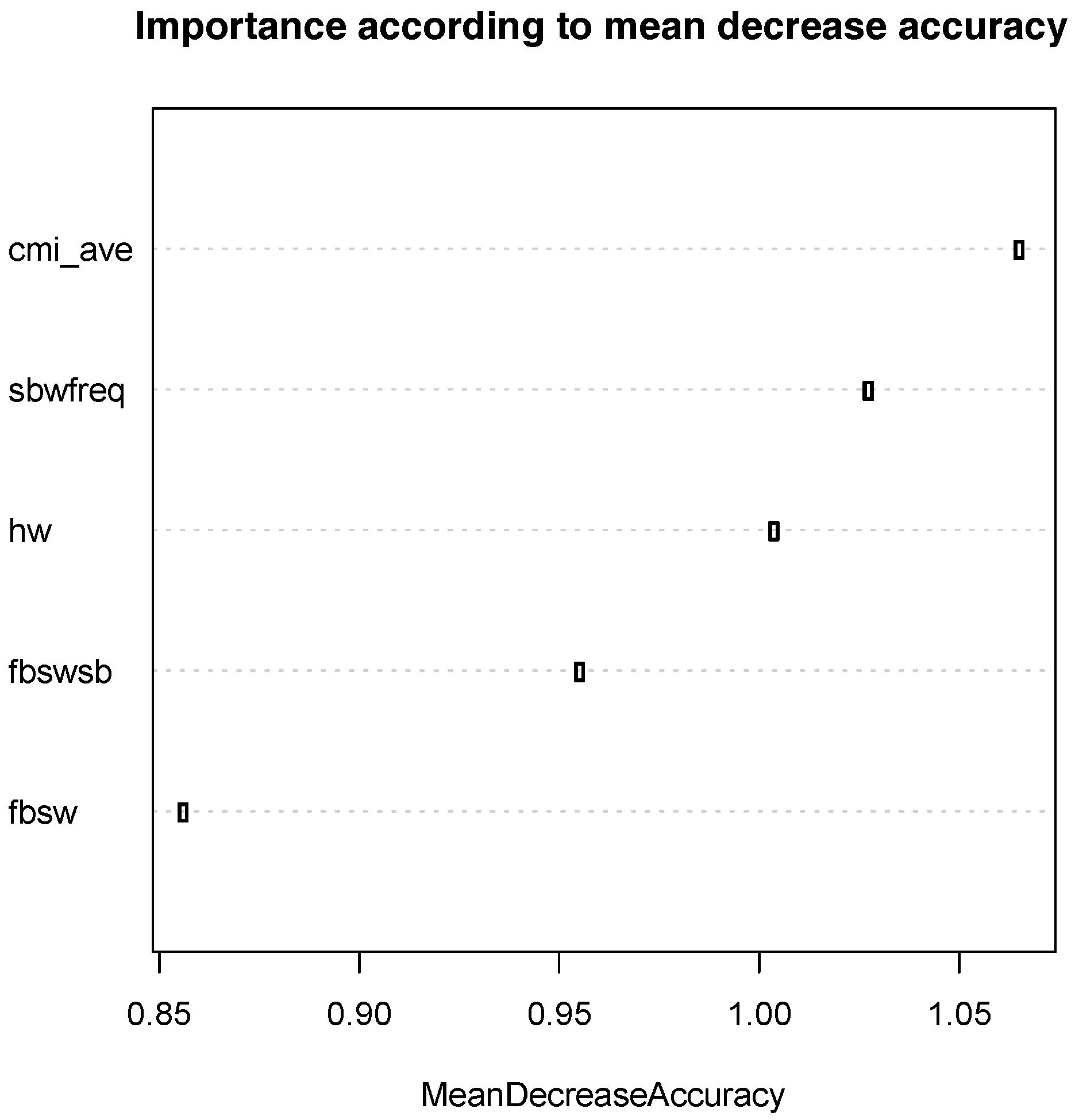
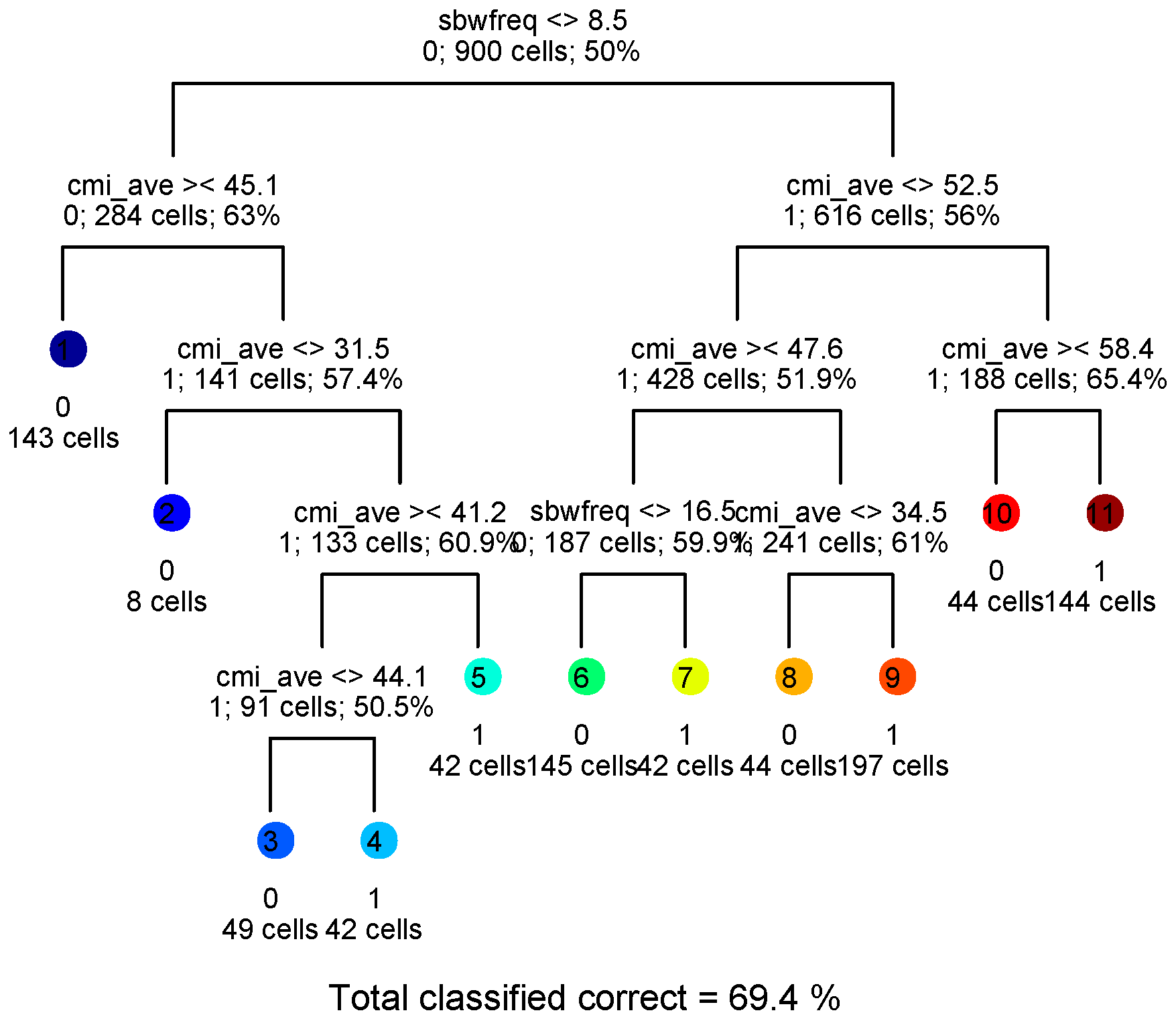
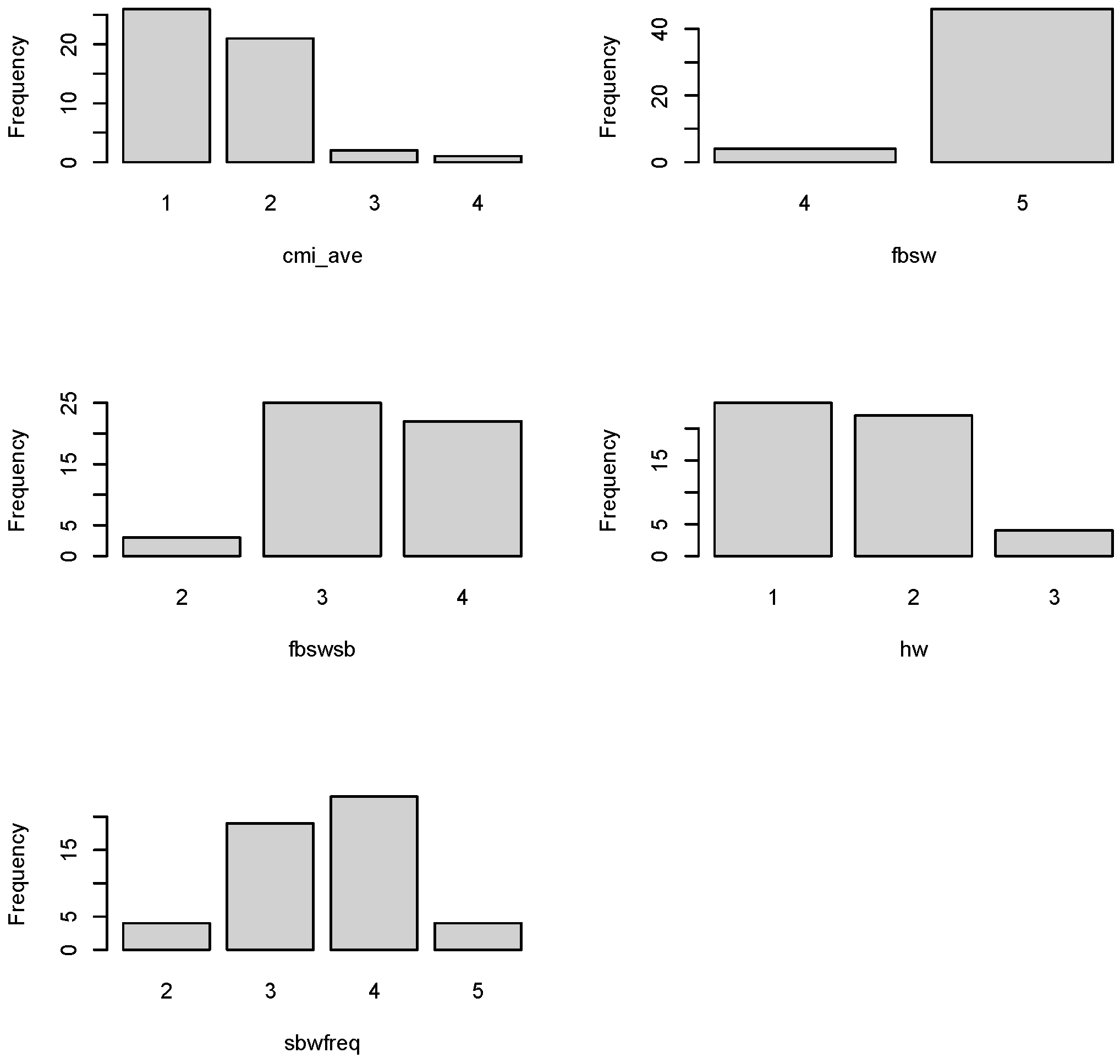
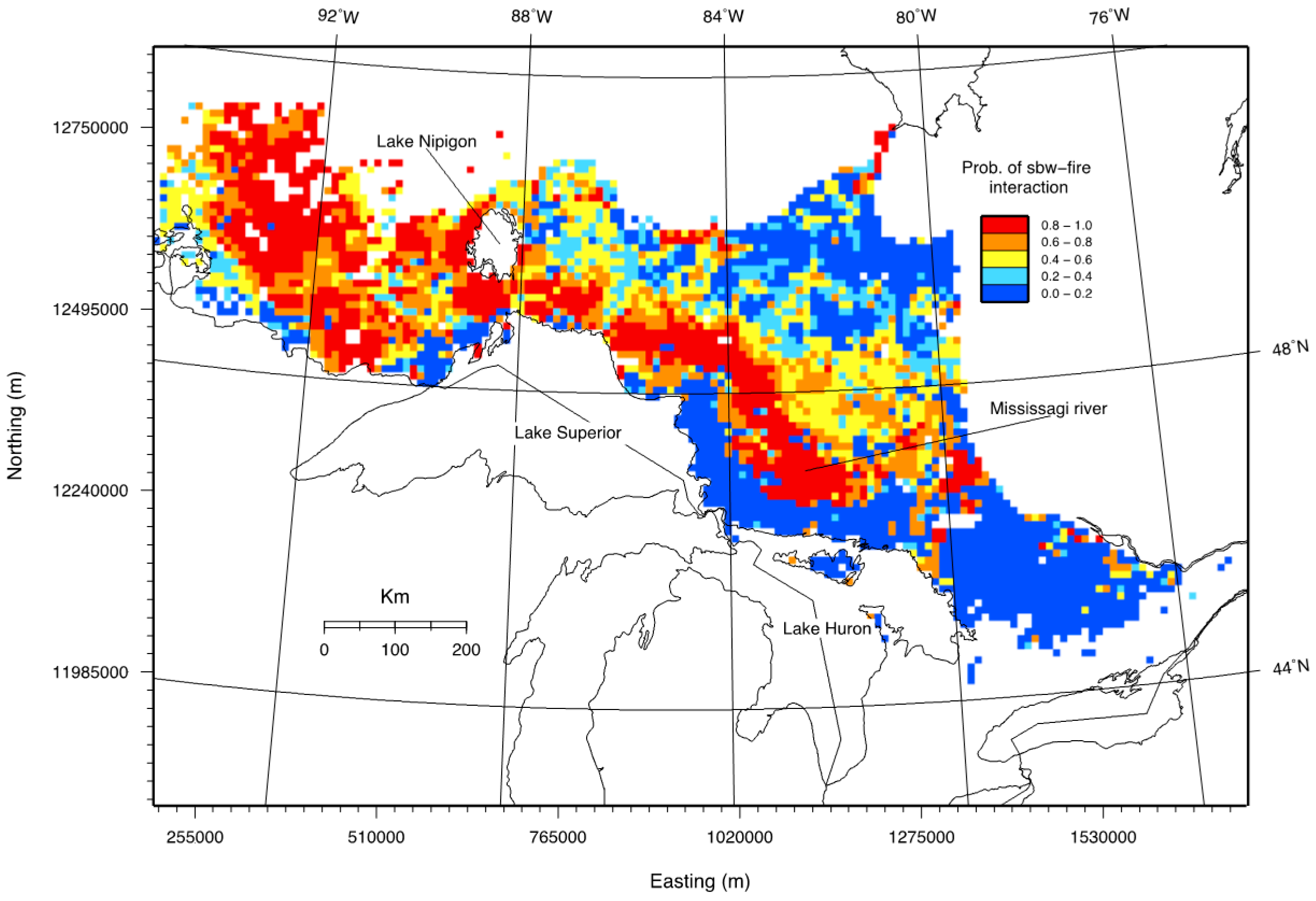
| cmi_ave | FbSw | FbSwSb | hw | sbwfreq | |
|---|---|---|---|---|---|
| cmi_ave | 1 | −0.02 | −0.09 | 0.33 | −0.09 |
| FbSw | −0.02 | 1 | 0.22 | 0.01 | 0.18 |
| FbSwSb | −0.09 | 0.22 | 1 | −0.77 | −0.03 |
| Hw | 0.33 | 0.01 | −0.77 | 1 | −0.07 |
| sbwfreq | −0.09 | 0.18 | −0.03 | −0.07 | 1 |
© 2018 by the authors. Licensee MDPI, Basel, Switzerland. This article is an open access article distributed under the terms and conditions of the Creative Commons Attribution (CC BY) license (http://creativecommons.org/licenses/by/4.0/).
Share and Cite
Candau, J.-N.; Fleming, R.A.; Wang, X. Ecoregional Patterns of Spruce Budworm—Wildfire Interactions in Central Canada’s Forests. Forests 2018, 9, 137. https://doi.org/10.3390/f9030137
Candau J-N, Fleming RA, Wang X. Ecoregional Patterns of Spruce Budworm—Wildfire Interactions in Central Canada’s Forests. Forests. 2018; 9(3):137. https://doi.org/10.3390/f9030137
Chicago/Turabian StyleCandau, Jean-Noël, Richard A. Fleming, and Xianli Wang. 2018. "Ecoregional Patterns of Spruce Budworm—Wildfire Interactions in Central Canada’s Forests" Forests 9, no. 3: 137. https://doi.org/10.3390/f9030137
APA StyleCandau, J.-N., Fleming, R. A., & Wang, X. (2018). Ecoregional Patterns of Spruce Budworm—Wildfire Interactions in Central Canada’s Forests. Forests, 9(3), 137. https://doi.org/10.3390/f9030137





